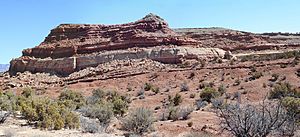Entrada Sandstone facts for kids
Quick facts for kids Entrada SandstoneStratigraphic range: Middle Jurassic |
|
|---|---|

Type of the Entrada Formation at Entrada Point, Emery County, Utah
|
|
| Type | Geological formation |
| Sub-units | Cannonville Member, Cow Springs Member, Dewey Bridge Member, Escalante Member, Henrieville Member, EExeter Member, Gunsight Butte Member, Iyanbito Member, Moab Member, Red Mesa Member, Slick Rock Member |
| Underlies | Curtis Formation |
| Overlies | Carmel Formation |
| Lithology | |
| Primary | fluvial mudstone, siltstone, and eolian sandstone |
| Location | |
| Coordinates | 39°15′40″N 110°32′35″W / 39.261°N 110.543°W |
| Region | Colorado Plateau |
| Country | United States |
| Type section | |
| Named for | Entrada Point, northern San Rafael Swell |
| Named by | James Gilluly and J.B. Reeside, Jr. (1928) |

The Entrada Sandstone is a special type of rock layer found in the western United States. It's part of a larger group of rocks called the San Rafael Group. You can find the Entrada Sandstone in states like Wyoming, Colorado, New Mexico, Arizona, and Utah.
This rock layer formed a very long time ago, during the Jurassic period. That was between 180 and 140 million years ago! Back then, the area was a mix of different environments, including sandy beaches, muddy tidal flats, and even huge sand dunes, like a big desert. This desert environment, with its vast sand seas (called ergs), was located around a shallow ancient ocean known as the Sundance Sea.
Discovering Entrada Sandstone
The Entrada Sandstone was formed during the Middle Jurassic period, around 165 million years ago. The place where this rock unit was first officially described and named is called Entrada Point. This spot is in the northern part of the San Rafael Swell in Emery County, Utah.
Two scientists, James Gilluly and Reeside, first named the Entrada Sandstone in 1928. They described it as one of four main rock layers in the San Rafael Group. They noted that the Entrada layer sits on top of the Carmel Formation and is covered by the Curtis Formation. In some areas, like northeastern Arizona, the Entrada is covered by the Wanakah Formation.
Many geologists have studied the Entrada Sandstone over the years. Gregory and Moore mapped out how far it spread in 1931. Later, in 1970, Thompson and Stokes divided it into different smaller sections, which they called "members." The most detailed study of the Entrada Sandstone was written by Peterson in 1988.
-
The Entrada Sandstone is covered by the Curtis Formation in Capitol Reef National Park.
Different Layers of Entrada Sandstone
The Entrada Sandstone isn't just one solid layer; it's made up of several different parts, called "members." Each member has its own unique features. Here are some of them:
- Cannonville Member (Utah)
- Cow Springs Member (Arizona)
- Dewey Bridge Member (Colorado, Utah) - This layer is named after a place called Dewey Bridge. It often looks like brick-red blocks of rock.
- Escalante Member (Utah)
- Henrieville Member (Utah)
- Exeter Member (New Mexico)
- Gunsight Butte Member (Utah)
- Iyanbito Member (New Mexico)
- Moab Member or Moab Tongue (Colorado, Utah) - Named after the town of Moab, Utah. This part is often a whitish sand layer from ancient inland dunes. It forms the "cap rock" on top of famous arches like Delicate Arch and Broken Arch in Arches National Park.
- Red Mesa Member (Arizona, New Mexico, Utah)
- Slick Rock Member (Colorado, Utah) - Named after Slick Rock, Colorado. This layer was formed from rounded beach sands that were cemented together, making a very smooth, uniform rock.
Where You Can Find It
The Entrada Sandstone is found in many different geological areas and national parks across the western United States.
It is found in these large geological regions:
- Anadarko Basin
- Black Mesa Basin
- Denver Basin
- Great Basin province
- Green River Basin
- Las Vegas-Raton Basin
- Paradox Basin
- Piceance Basin
- Plateau sedimentary province
- San Juan Basin
- Sierra Grande Uplift

You can also see the Entrada Sandstone in many beautiful parklands, including:


